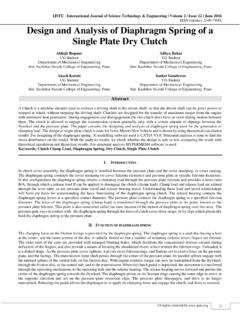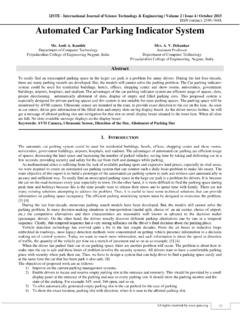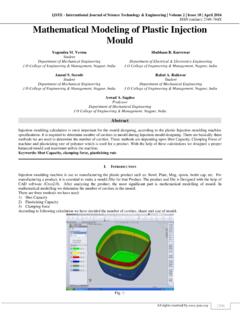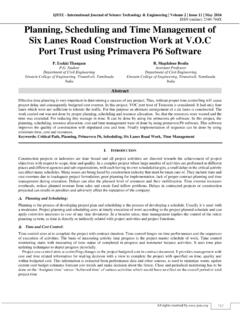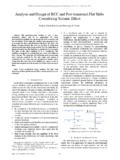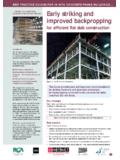Transcription of A Review on Seismic Assessment of Post-Tensioned …
1 IJSTE - International Journal of Science Technology & Engineering | Volume 2 | Issue 12 | June 2016 ISSN (online): 2349-784X All rights reserved by 475 A Review on Seismic Assessment of Post-Tensioned flat Slab Shriraj S. Malvade P. J. Salunke PG Student Assistant Professor Department of Civil Engineering Department of Civil Engineering MGM s College of Engineering and Technology MGM s College of Engineering and Technology Abstract The use of Post-Tensioned flat slab is increasing widely, due to its advantages over traditional concrete. These slabs have been proved to be the most economical when compared to the RCC slabs. As these slabs are very easy to construct, Post-Tensioned slabs are preferred for industrial, commercial and residential floor slab construction. Majorly because of the relatively thin slab depths, lighter in weight and smaller floor to floor heights, Post-Tensioned slabs have been used for such construction.
2 In Post-Tensioned slab high strength tensioned steel strands are used to compress the slab, keeping the majority of the concrete in compression. This gives a very efficient structure which minimizes material usages and decreases the economic span range when compared to reinforced concrete. By the study of literature in the research areas of Post-Tensioned Slab technique, some secondary moment effects are observed in the analysis of this slab. These effects combine with lateral loading causing critical issue in design of slab. The behaviour and response of flat slab and post tensioned flat slab during earthquake is an important aspect which needs to be explored. The main objective of this paper is to give a Review on the response and behavioural properties of Post-Tensioned flat slab during earthquake and compare with normal flat slab.
3 Keywords: Column Capital, Drop Panel, flat Slab, Floor System, Non-Linear Analysis, Post-Tensioned Slab _____ I. INTRODUCTION With increase in demand for space, construction of multi-storeyed buildings is becoming a necessary part of our living style. The dearth of space is forcing us to raise the height of buildings as much as possible to accommodate maximum number of people and also in harmony with the architectural necessities. These multi-storeyed buildings can be constructed using various structural systems. Also with increase in height the need of resisting lateral loads like wind and earthquake also comes in picture. Two main groups according to the arrangement of slabs, beams or girders and columns are (1) Framed structure and (2) flat slab structure. flat slab buildings can be broadly divided into RCC and Prestressed buildings.
4 The choice of a particular system depends upon the total height of the building commercial or residential etc. and finally the total cost of the structure. The flat slab or post tensioned Slab buildings in which slab is directly rested on columns, have been adopted in many buildings constructed recently due to the advantage of reduced floor to floor heights to meet the economical and architectural demands. For commercial buildings flat slab rising up to 10 to 20 stories is quite popular. But Punching shear failure observed during the transfer of unbalanced moment from slab to column is the main drawback of using flat slab. Also its behaviour during earthquake due to absence of beams is also the mater to study. This dissertation mainly focuses on the Seismic behaviour of RCC flat slabs.
5 Floor System The slabs are presented in two groups viz. one-way slabs and two-way slabs. When a rectangular slab is supported on all the four sides and the length-to-breadth ratio is less than two, it is termed as a two-way slab. The slab spans in both the orthogonal directions. Rectangular two-way slabs are divided into the following types: 1) flat plates: The flat plate slabs do not have beams between the columns, drop panels or column capitals. Usually, there are spandrel beams at the edges. 2) flat slabs: These slabs do not have beams but have drop panels or column capitals. 3) Two-way slabs with beams: There are beams between the columns. If the beams are wide and shallow, they are termed as band beams. For long span construction, there are ribs in both the spanning directions of the slab.
6 This type of slabs is called waffle slabs. The slabs can be cast-in-situ (cast-in-place). Else, the slabs can be precast at ground level and lifted to the final height. The latter type of slabs is called lift slabs. A slab in a framed building can be a two-way slab depending upon its length-to-breadth (L / B) ratio. Two-way slabs are also presented as mat (raft) foundation. The following sketches show the plan of various cases of two-way slabs. The spanning directions in each case are shown by the double headed arrows. A Review on Seismic Assessment of Post-Tensioned flat Slab (IJSTE/ Volume 2 / Issue 12 / 086) All rights reserved by 476 Fig. 1: The plan of various cases of two-way slabs flat Slabs: The Conventional method of construction that is a common practice is to support slab by beam; and beam supported by column.
7 This is called as a beam slab load transfer construction technique. Due to this traditional technique of construction net height of the room is reduced. Thus to improve the aesthetical and structural aspect of multi-storey, shopping malls, offices, warehouses, etc. are constructed in such a way where slabs are directly on columns. This type of slab which is directly supported on columns is termed as flat slab. Necessity A lot of research work has been carried out and still active in the analysis and design of Post-Tensioned flat slabs. While analysing the Post-Tensioned slab, there are some secondary moment effects observed. These secondary moment effects when combined with lateral loading become a critical issue in the design of slab. Due to this, there arises an urge to study the behaviour and response of flat slabs and post tensioned flat slabs during an earthquake.
8 Another arising issue in the present scenario is the scarcity of space which is compelling us to raise the height of buildings to accommodate the growing population. This increase in the height of building enforces consideration of the factors such as lateral loads like wind and earthquake while design and analysis of the structure. The examples for the construction of flat Plate and flat Slabs can be seen from the following photographs below: Fig. 2: Post-Tensioned flat Slab Fig. 3: Post-Tensioned flat Plate A Review on Seismic Assessment of Post-Tensioned flat Slab (IJSTE/ Volume 2 / Issue 12 / 086) All rights reserved by 477 II. LITERATURE Review Introduction post -Tensioning is a vast field and huge research has been carried out on it. Many researchers have worked and contributed their efforts for the study of the Seismic behaviour of Post-Tensioned flat slab.
9 This report gives an overview of the study and research from some of the International journals published around the world. The main aim of this study is to study the research carried by various researchers. Review of Literature In 2008, U. Prawatwong performed an experimental study on the Seismic performance of scale Post-Tensioned (PT) interior slab-column connection models one without drop panel and another one with drop panel. Both models were tested under a constant gravity load. A conventional displacement-controlled cyclic loading routine with monotonically increasing drift levels until failure was adopted to investigate the Seismic performance. They concluded that the model without drop panel abruptly failed by punching shear shortly after attaining its maximum lateral strength at drift, while the improved model experienced a saturation of lateral peak load from about to drift prior to punching shear.
10 In 2004, Virote Boonyapinyo analyzed Post-Tensioned concrete slab-column frame buildings by pushover analysis. The analysis results, presented in the form of capacity curves and they are compared with the Seismic demand from the expected earthquake ground motion at Bangkok site and then the Seismic performance evaluated, where several important factors such as P-Delta effects, strength and stiffness contributions from masonry infill walls, and foundation flexibility are well taken into account. The results show that in general Post-Tensioned concrete slab-column frame buildings possess relatively low lateral stiffness, low lateral strength capacity, and poor inelastic response characteristics. The evaluation also shows that the slab-column frame combined with the shear wall system and drop panel can increase the strength and stiffness significantly.

